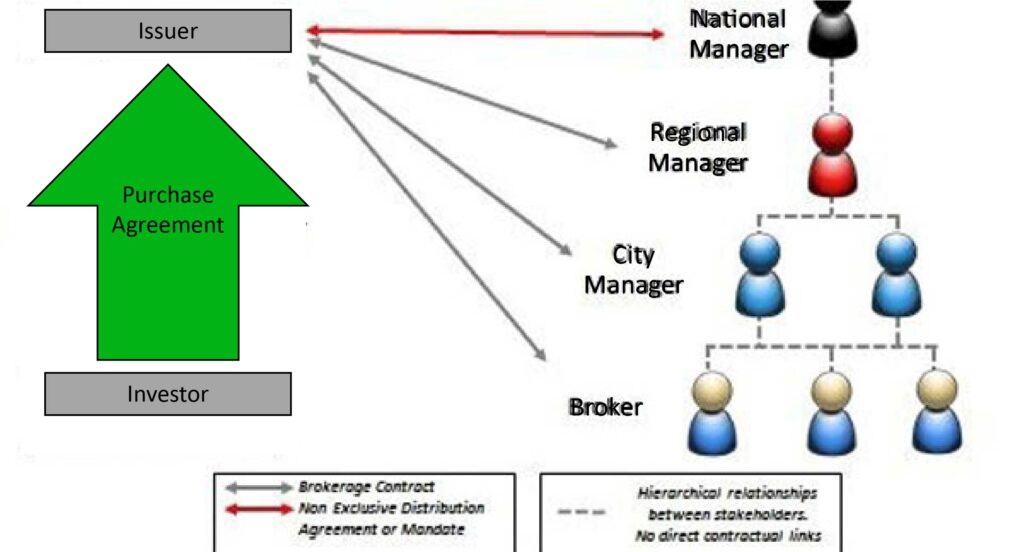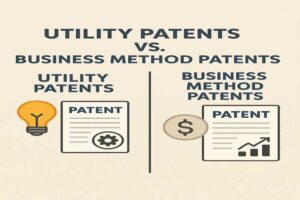The Multilevel Brokerage Network (MBN) is a unique evolution in the realm of multilevel marketing networks.
As the model can work both for the Busines-to-Business (“B2B”) and Busines-to-Consumer models (“B2C”) we will respectively use the Consumer for the B2C model and Buyer for the B2B model.
Distinctly different from conventional models, the MBN involves just a single sale of a product or service from the company to the Consumer or Buyer.
This one-time transaction mechanism makes it a significant departure from the stereotypical ‘pyramid’ structure that dominates most multilevel marketing strategies who consider their sales representative as their target purchasers.
In a conventional pyramid sales system, products or services are sold at various levels, often leading to complications and misinterpretations.
However, the MBN negates the existence of such a pyramid sale scenario.
Instead, it relies on a pyramid commissioning system, which, contrary to common perceptions, is entirely legal and ethical, because it is the main system used by insurance companies to sell their policies.
This shifts the focus from sales to commissions earned on these sales, eliminating the infamous drawbacks of pyramid selling, and presenting a more transparent and trustworthy model for the brokers, the buyers and/or the consumers.
The design of the MBN is intriguingly polymorphic.
Its flexible structure is adept at distributing a plethora of products and services, utilizing a variety of distributors, who could be natural or legal entities of all sizes and backgrounds.
This malleable nature of the MBN makes it highly adaptable and beneficial to accommodate different industries, products, and distributor capacities.
It tailors itself seamlessly to the varying needs of different participants, making it a versatile platform for businesses and investors alike.
The role of the Broker in this network is an interesting one.
Unlike traditional systems, where the broker often plays multiple roles, in the MBN, the broker primarily functions as a bridge between the Company and the Consumer or Buyer.
This clarity and simplicity in role definition eliminates confusion and fosters better communication and transactions between the involved parties.
In the MBN, the sales contract is established directly between the Company and the Consumer or Buyer.
The Broker merely facilitates this connection, devoid of any obligation to acquire products or invest in inventory for sale.
This direct agreement between the producer and the Consumer or Buyer ensures a transparent transaction, devoid of any hidden clauses or conditions.
Moreover, by eliminating the broker’s need to maintain inventory, the MBN removes one of the most challenging aspects of traditional brokerage – inventory management.
This innovative system allows brokers to center their attention and efforts on their core mission – that of prospecting and selling.
This focus on the essential tasks enables them to deliver better, optimize their performance, and reap greater rewards.
The system also allows brokers to ensure their own success by allowing them to sell the products distributed by the company.
They don’t just act as intermediaries; they are partners in the company’s growth, with their success tied directly to their sales performance.
This enhances the broker’s role from just a facilitator to an integral part of the business, with a stake in the company’s growth and profits.
Another enticing feature of the MBN is the opportunity it offers to the brokers to distribute multiple products and services.
These could span across a wide range of sectors, including but not limited to, telephony cards, alternative payment methods, beverages, cosmetics, and fashion.
This diversity not only broadens the horizons for the brokers but also provides them with greater market exposure, consumer understanding, and operational skills in various domains.
The prospect of dealing with multiple products and services also amplifies the potential for profit. The more varied the products, the wider the customer base and higher the chances of sales.
This, coupled with the fact that the broker’s commission is based on sales, means that the potential for earning is not just substantial but also scalable.
The broker enters into a brokerage contract with the Company, formalizing the relationship between the two.
This contract serves as a legally binding agreement that outlines the terms and conditions, the roles and responsibilities of the broker, and the commission details.
The broker then receives commissions based on the purchases made by their customers or buyers.
This arrangement puts the control in the hands of the brokers – the more effectively they can sell, the more they stand to earn.
This commission-based system is simple, transparent, and has a direct correlation with the efforts put in by the brokers.
Unlike many traditional multilevel marketing networks where the brokers are often in the dark about their earnings until the end of the cycle, the MBN provides a clear, upfront picture of the earning potential.
This transparency goes a long way in building trust and confidence among the brokers, increasing their motivation, and ultimately leading to better performance and higher sales.
Furthermore, the MBN model also allows for continuous learning and growth for brokers. By being exposed to different industries, products, and services, brokers have the opportunity to gain valuable insights and experience across multiple domains.
This knowledge not only enhances their selling skills but also aids in their personal and professional growth.
The MBN also provides a platform for healthy competition among brokers.
Since the earning potential is directly related to the sales performance, it encourages brokers to outperform not just others but also their own past performances.
This competitive environment fosters innovation and creativity, driving the brokers to find new, effective ways of selling, enhancing their skills, and improving their results.
By eliminating the need for brokers to manage inventory, the MBN significantly reduces the operational complexities and costs associated with the traditional brokerage model.
Brokers no longer have to worry about storage, handling, and stock rotation. They also don’t have to bear the risks of stock obsolescence, depreciation, or damages. By freeing brokers from these responsibilities, the MBN enables them to focus solely on their primary task – selling.
Moreover, the MBN is not just beneficial for brokers but also for the companies.
By establishing a direct contract with the investors, companies can maintain better control over their sales process.
They can monitor their sales performance more accurately, get direct feedback from the investors, and make necessary adjustments in their strategies, products, or services more quickly and effectively.
The MBN is also advantageous for the investors. Since the sales contract is made directly with the company, investors can enjoy a more straightforward and transparent purchasing process.
They can have direct communication with the company, get more accurate and detailed information about the products or services, and make more informed purchasing decisions.
Furthermore, they can also get better customer service and support directly from the company.
In a nutshell, the Multilevel Brokerage Network is a revolutionary model in the multilevel marketing landscape.
It is designed to optimize the selling process, maximize the earning potential, and minimize the operational hassles for brokers.
It also enhances the transparency, control, and effectiveness of the sales process for the companies, while providing a more trustworthy and reliable purchasing process for the investors.
By merging the best of both worlds – the flexibility of multilevel marketing and the simplicity of traditional brokerage, the MBN is set to redefine the rules of the game.
It is a potent blend of innovation, legality, and profitability that promises to transform the future of multilevel marketing networks.
The MBN is not just a new business model; it is a new way of doing business, designed to adapt to the changing market dynamics, cater to the evolving needs of the participants, and capitalize on the emerging opportunities in the marketplace.







